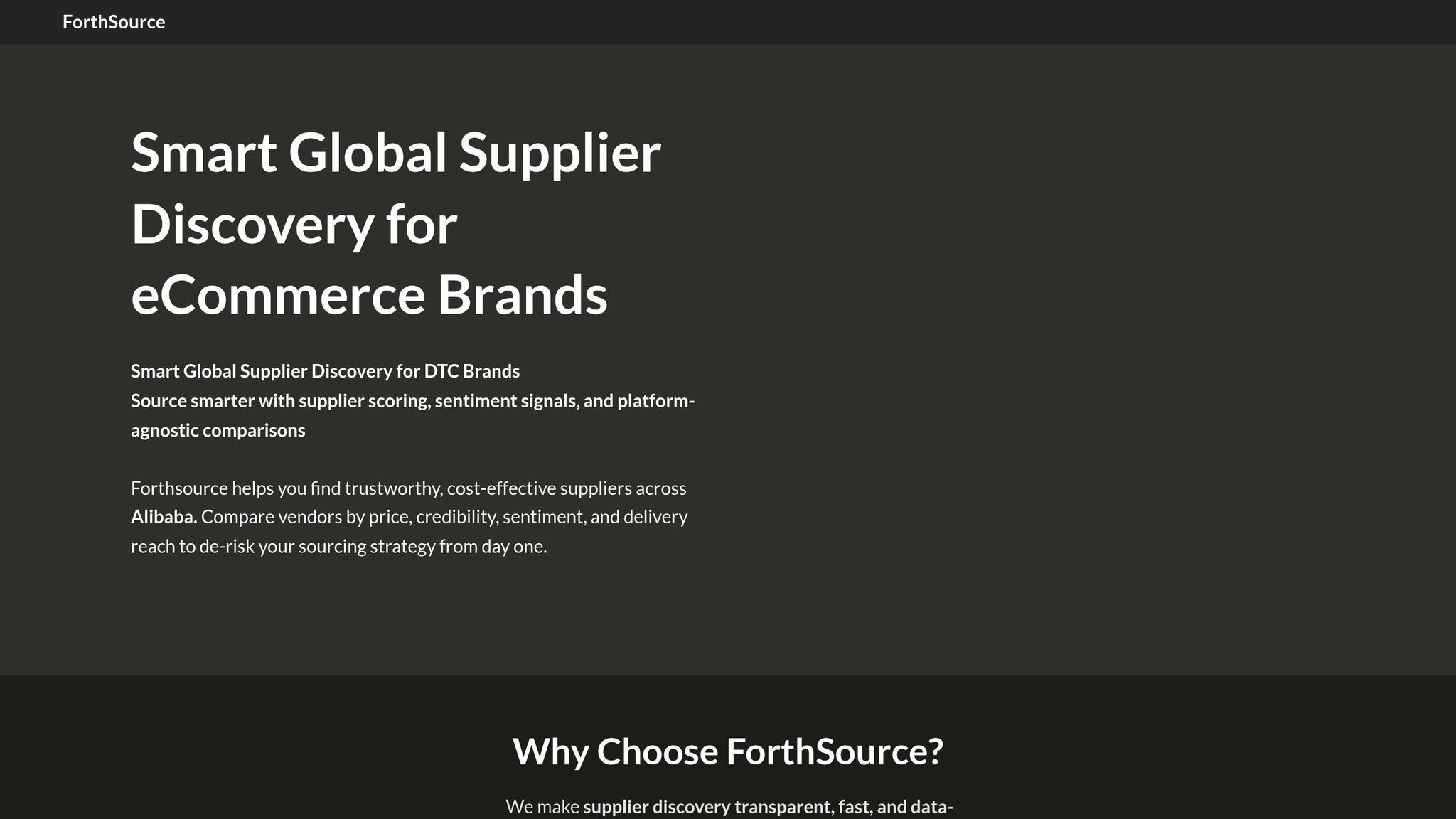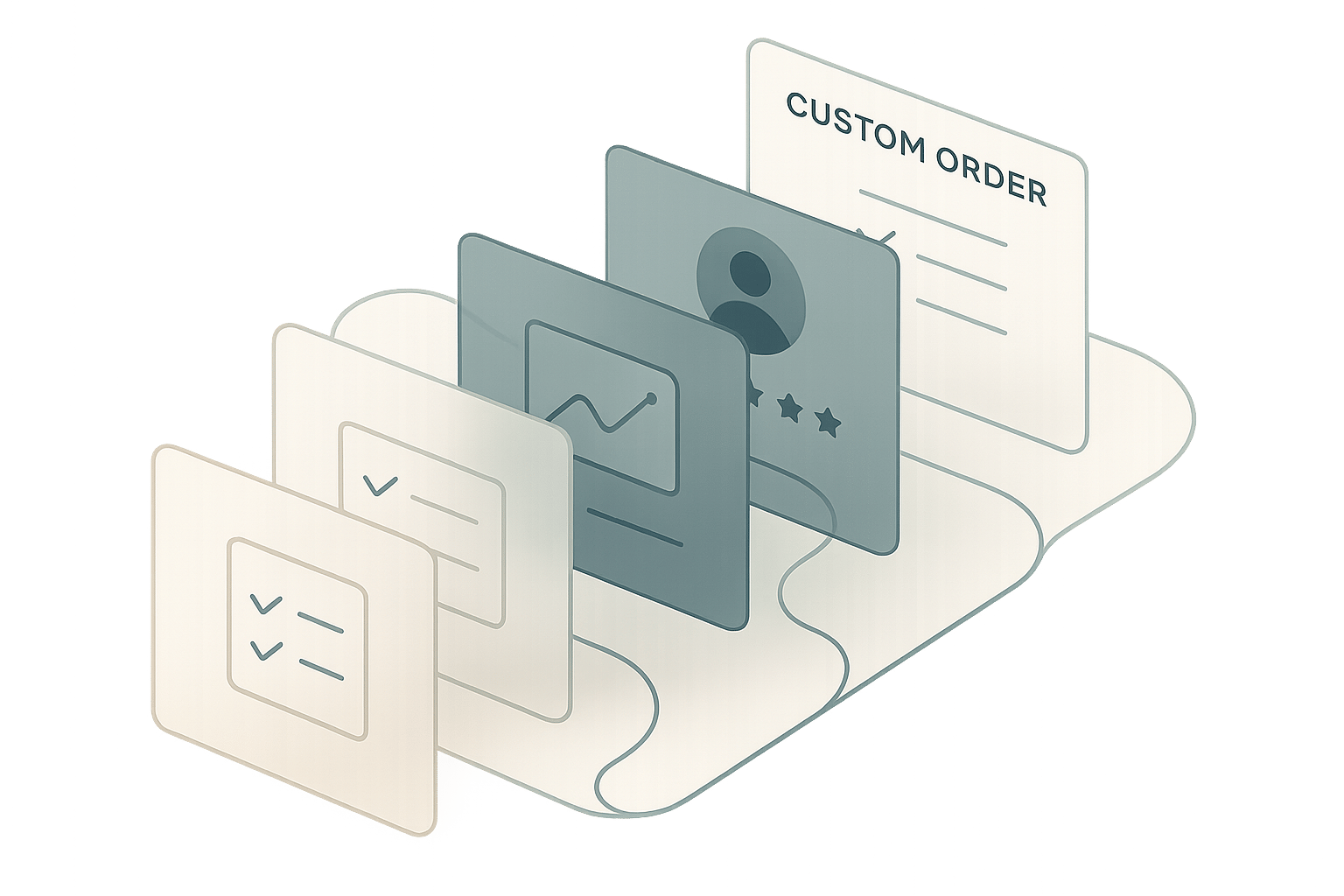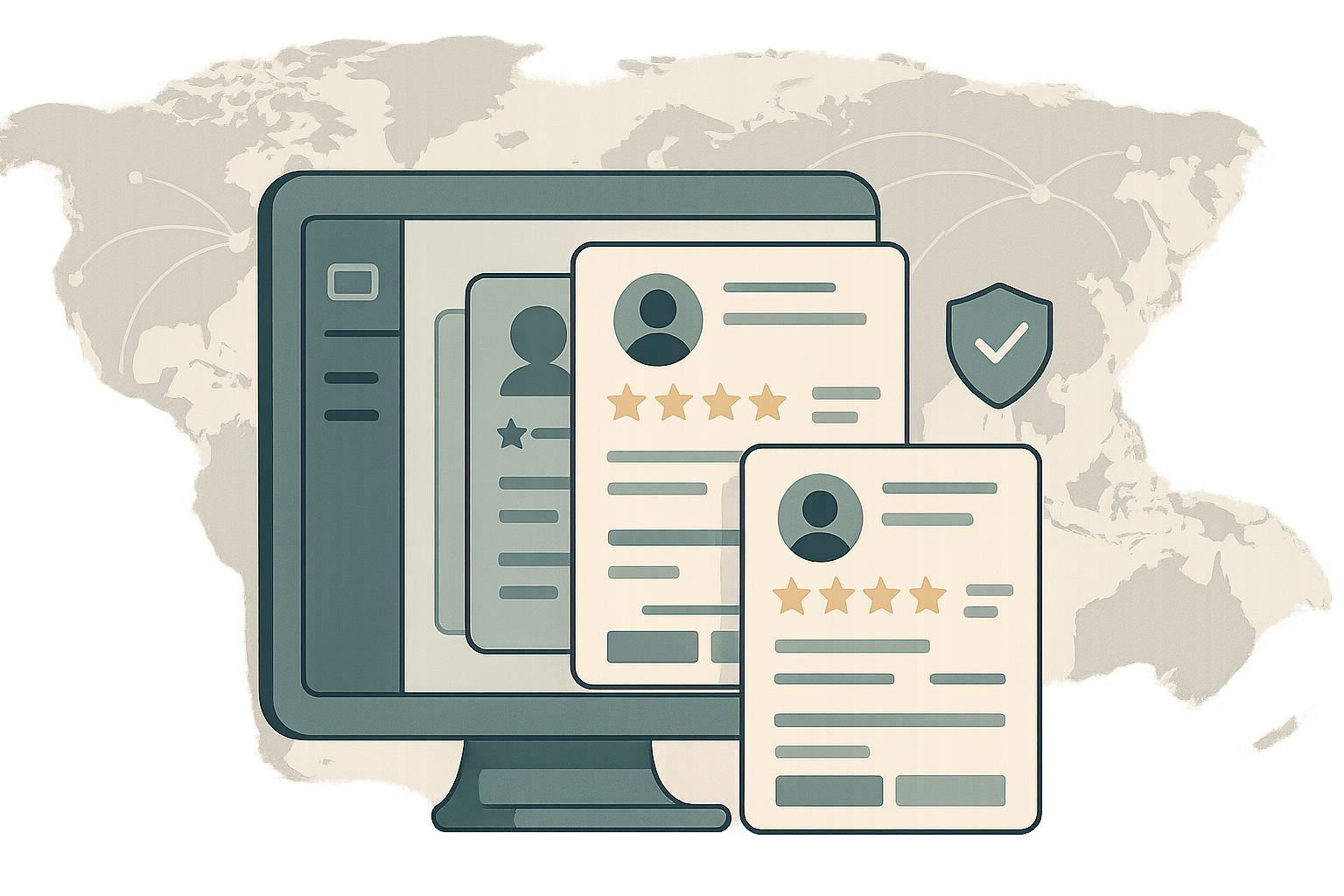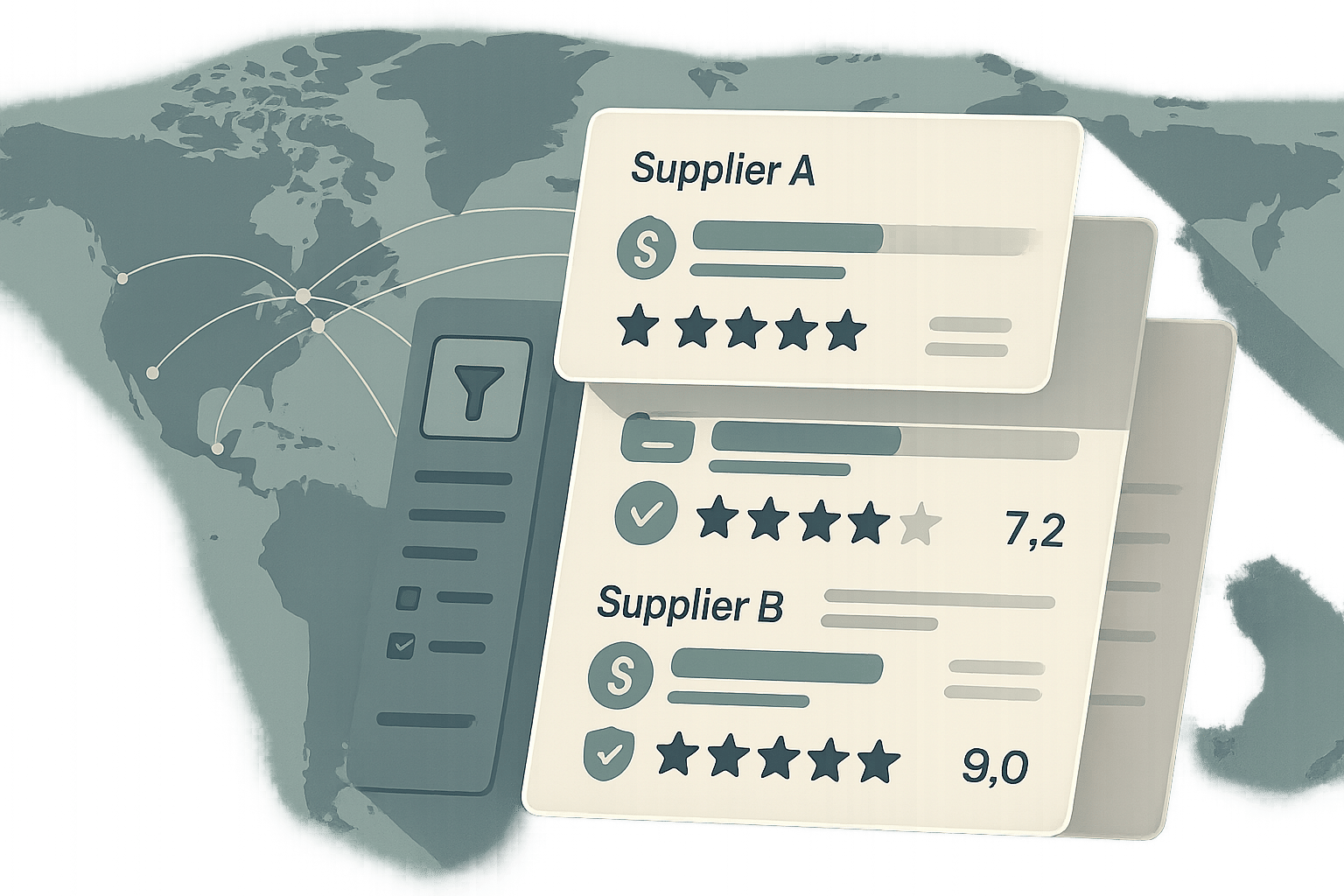Building strong, lasting relationships with suppliers is essential for smoother operations, cost savings, and reduced risks. Treating suppliers as partners rather than just vendors leads to better collaboration, faster problem-solving, and improved supply chain performance. Here’s how you can achieve that:
- Trust and Communication: Pay on time, communicate openly, and schedule regular check-ins to align expectations and resolve issues early.
- Use Technology: Tools like supplier relationship management (SRM) software streamline communication, track performance, and reduce disruptions.
- Set Clear Agreements: Document quality standards, delivery timelines, payment terms, and compliance requirements to avoid misunderstandings.
- Track Performance: Use KPIs like on-time delivery and product quality to monitor suppliers and drive continuous improvement.
- Fair Practices: Offer fair payment terms, incentives, and long-term contracts to build mutual respect and loyalty.
- Recognition: Acknowledge and reward top-performing suppliers to strengthen partnerships.
Key Principles of Supplier Relationship Management
Set Up Clear and Consistent Communication
Building strong relationships with suppliers starts with clear and open communication. When everyone understands expectations, timelines, and responsibilities, things tend to flow more smoothly. According to a McKinsey study, companies that use digital tools for supplier management see a 15-25% drop in supply chain disruptions, thanks to better communication and transparency.
But communication isn’t just about passing along information - it’s about creating a foundation of trust and collaboration. When suppliers feel heard and valued, they’re more likely to prioritize your needs and even share ideas that could benefit your operations. To make this happen, regular and structured communication is key.
Schedule Regular Check-Ins and Updates
When it comes to supplier communication, consistency is key. Setting up regular meetings - whether monthly or quarterly - provides an opportunity to review performance, address challenges, and explore new opportunities.
These meetings should follow a structured agenda covering three main areas: performance reviews, potential challenges, and future plans. This ensures both sides come prepared and the discussions remain productive. After each meeting, document key action items, deadlines, and responsibilities. This not only keeps everyone accountable but also provides a record for future reference.
Many companies also track metrics like response times and issue resolution speeds as indicators of how effective their communication is. Additionally, inviting suppliers to share feedback on your processes - like payment terms or forecasting accuracy - can uncover opportunities for improvement that you might otherwise overlook.
Use Digital Tools for Better Collaboration
Managing supplier relationships through paper trails and endless email chains can quickly get chaotic. Digital platforms offer a smarter way to centralize communication and collaboration.
Tools like supplier relationship management (SRM) software, Slack, Microsoft Teams, or shared document repositories help streamline interactions. These platforms allow teams to track conversations, share updates, and maintain visibility across all stakeholders. Real-time updates are especially helpful - automated alerts for order changes, delivery updates, or quality issues ensure everyone stays informed without waiting for weekly calls. Some companies even use shared dashboards where suppliers can access real-time data on order forecasts, inventory levels, and performance metrics.
For direct-to-consumer (DTC) brands, platforms like ForthSource make finding reliable suppliers easier. These tools aggregate product information and use scoring systems based on price, credibility, and quality, helping brands make smarter decisions while maintaining transparency with suppliers. Digital tools like these create a foundation for clear, documented agreements.
Write Down Expectations and Agreements
Clear documentation is a cornerstone of reliable supplier relationships. By writing down all key terms, you minimize misunderstandings and set the stage for long-term success. Include details like quality standards, delivery timelines, payment terms, and compliance requirements.
Service-level agreements (SLAs) are especially useful. They outline specific deliverables, quality benchmarks, and response times, ensuring that everyone is on the same page. Similarly, standard operating procedures (SOPs) can clarify your processes, approval workflows, and escalation methods. These documents not only act as a reference when questions arise but also help onboard new team members quickly.
Don’t forget compliance requirements, particularly if you operate in industries with strict regulations around product safety, labeling, or documentation. Make sure your suppliers understand these requirements and have systems in place to meet them consistently.
It’s also wise to establish dispute resolution processes. Disagreements are bound to happen, and having a clear escalation path can save time and maintain relationships. Define who handles specific types of issues, what information is required, and how quickly resolutions should be reached.
Finally, schedule regular contract reviews - ideally on an annual basis. This helps ensure agreements stay aligned with your evolving business needs and market conditions. Use these reviews to update terms, adjust volumes, and incorporate lessons learned from the past year.
Track Performance and Drive Continuous Improvement
Once clear communication is in place, the next step is tracking supplier performance. This isn't just about keeping tabs - it's about creating opportunities for growth on both sides.
Performance tracking provides the data you need to make informed decisions while signaling to suppliers that high standards matter. Start by defining clear KPIs to measure and compare performance effectively.
Set Measurable KPIs for Supplier Performance
Tracking performance begins with selecting the right metrics. Focus on areas like product quality, on-time delivery, and cost efficiency.
For product quality, look at defect rates, return rates, and adherence to your specifications. Delivery performance can be evaluated by tracking on-time delivery percentages, lead time accuracy, and how well suppliers communicate potential delays. Cost efficiency goes beyond just unit price - consider the total cost of ownership. Also, assess supplier responsiveness and their ability to adapt to changes.
Here are some key KPIs to consider:
| KPI | Description | Example Target Value |
|---|---|---|
| On-Time Delivery | % of orders delivered on time | 98% |
| Product Quality | % of defect-free products | 99.5% |
| Cost Efficiency | % reduction in procurement costs | 10% |
| Customer Satisfaction | Internal team supplier ratings | 4.5/5 |
Platforms like ForthSource can help consolidate this data into trust scores, making it easier to evaluate supplier performance at a glance.
Use Performance Reviews to Find Gaps
Performance reviews should be a regular part of managing supplier relationships - not just a one-off task. These evaluations provide a structured way to highlight strengths and address weaknesses early.
Take, for example, Unilever's approach in 2022. They implemented a system to track KPIs like delivery accuracy and product quality across 1,200 suppliers. By holding monthly review sessions, they achieved a 12% improvement in on-time deliveries and reduced product defects by 9% over 18 months. The result? $18 million in cost savings.
A good review process includes scheduled meetings where both sides discuss challenges, market shifts, and areas for improvement. Benchmarking against industry standards and documenting progress keeps everyone motivated and aligned. These reviews aren't just about identifying problems - they're about creating actionable feedback that drives meaningful change.
Collect Feedback for Process Optimization
Building on performance reviews, a two-way feedback loop is essential for optimizing processes. Encourage suppliers to share insights about their operations and what support they need to succeed.
For instance, Siemens took this approach in June 2023 by using vendor management software to automate performance tracking and feedback collection. This reduced manual reporting errors by 28% and shortened their procurement cycle by 22 days. Automation tools can simplify the process by generating reports, prompting feedback, and tracking responses.
Use supplier feedback to spot recurring issues and fine-tune your procedures. If multiple suppliers point out similar challenges, it's a clear sign that adjustments are needed. Regular performance assessments that incorporate this feedback can lead to continuous improvements, benefiting everyone involved.
Create Mutual Benefits and Build Trust
Trust thrives when both sides see value in the relationship. When suppliers view you as a true partner rather than just another customer, they’re more likely to prioritize your needs, offer better deals, and go the extra mile during tough times. A Deloitte survey found that 79% of companies with strong supplier relationships saw improved performance, and 74% experienced increased innovation. Consistent communication and dependable actions are key to fostering these benefits. These efforts build on earlier strategies by solidifying trust and ensuring shared success.
Offer Fair Payment Terms and Incentives
Money matters, and how you handle payments speaks volumes. Paying on time - or even early - demonstrates respect and reduces potential friction. For example, while 30-day payment terms are standard, offering early payment discounts can foster goodwill. This not only helps suppliers manage their cash flow but also strengthens your relationship.
Performance-based incentives are another way to motivate suppliers. Options might include volume discounts for consistent large orders, bonuses tied to quality standards, or exclusive contracts for top performers. Transparency is critical here - clear invoicing and quick resolution of disputes show you’re committed to a fair and efficient process.
Promote Long-Term Contracts and Risk Sharing
Long-term contracts bring stability to both sides, offering better pricing and predictable revenue. When negotiating these agreements, focus on shared responsibilities rather than one-sided protections. Service-level agreements (SLAs) can set clear expectations for everyone involved.
Risk-sharing is another way to deepen trust. Consider joint contingency plans for supply chain disruptions, escrow accounts for large payments, or shared insurance policies to address quality or delivery issues. You could also explore co-investing in critical equipment or technology with your suppliers. These efforts can increase capacity and secure better pricing, further strengthening the partnership.
Show Recognition and Appreciation
Sometimes, small gestures carry big weight. Publicly recognizing top-performing suppliers or sending a simple thank-you note can go a long way in boosting morale. Celebrating milestones, like business anniversaries, adds a personal touch that shows you value the relationship.
Consider organizing annual appreciation events or creating awards for categories like quality, reliability, or innovation. These initiatives not only celebrate achievements but also encourage healthy competition among suppliers. Consistent recognition keeps suppliers motivated and invested in your shared success, reinforcing the idea that your partnership is built to last.
sbb-itb-633367f
Use Technology for Supplier Discovery and Relationship Management
Technology has reshaped the way businesses discover and manage suppliers. While trust and fair terms remain the backbone of strong partnerships, digital tools take these relationships to the next level by simplifying processes like finding suppliers, tracking performance, and managing ongoing interactions.
Find Reliable Suppliers Faster with ForthSource

Gone are the days of manually searching for suppliers and relying on subjective evaluations. Platforms like ForthSource have revolutionized the process by aggregating supplier data from sources like Alibaba and combining it with a proprietary scoring system. This system evaluates suppliers based on factors such as pricing, credibility, WeChat activity, and legal reports, offering a data-driven approach to finding reliable partners. For DTC brands, this eliminates much of the guesswork.
ForthSource’s cross-platform comparison feature lets you assess supplier listings from major marketplaces like AliExpress, Alibaba, and DHGate. These listings are ranked in real-time for performance and reliability, giving you a single source for objective evaluations.
What sets ForthSource apart is its integration of sentiment signals from platforms like Google Reviews and Trustpilot. These real-time insights help you avoid suppliers with fake ratings or hidden issues. Plus, the platform allows you to save searches and track shortlisted suppliers, enabling you to build a comprehensive supplier playbook over time. This ensures continuity and consistency in your sourcing decisions as your business scales.
Use Automation to Streamline Processes
Once you’ve identified the right suppliers, automation tools can make managing these relationships much smoother. These tools handle repetitive tasks like purchase order processing, vendor payments, and performance tracking, freeing up your time for more strategic activities. Companies that use digital supplier management tools report a 20–30% reduction in procurement cycle times and a 15–25% drop in supply chain disruptions.
Automation can also simplify routine tasks such as electronic signatures, invoice processing, and contract renewals. For example, automated order tracking ensures everyone stays informed about shipment statuses without constant follow-ups. Additionally, automated systems keep performance metrics - like delivery times, quality scores, and compliance rates - up to date, feeding directly into regular reviews. This ensures that performance monitoring is consistent and actionable.
Reduce Risk Through Real-Time Data Insights
Real-time data offers a clear view of supplier performance, market trends, and potential risks. This level of transparency lets you make quick, informed decisions and resolve issues before they escalate. According to a Deloitte survey, 79% of organizations with advanced supplier relationship management tools report better cost savings and improved supplier performance.
Platforms like ForthSource enhance transparency by providing real-time credibility signals, such as domain reputation checks and legal report analyses. These tools help you identify potential risks early on. Additionally, region-specific confidence signals make it easier to manage risks when expanding into new markets. By maintaining continuous visibility into supplier performance, businesses can address problems collaboratively, ensuring risks are managed effectively while nurturing long-term partnerships.
Manage Contracts and Renewal Processes
Building strong supplier relationships requires contracts that grow alongside your business. The best partnerships rely on contracts that aren't just filed away after signing - they're dynamic agreements designed to protect both parties and adapt to changing needs.
Review and Update Contracts Regularly
Taking time to review contracts annually or biannually ensures they align with evolving market conditions and business goals. A Deloitte study found that 57% of organizations review supplier contracts at least once a year, and those that do often uncover opportunities for cost savings and operational improvements.
When conducting these reviews, focus on areas like pricing, delivery schedules, quality standards, and compliance requirements. Market shifts can render old terms outdated - what worked two years ago may no longer suit your needs. For example, if a supplier consistently delivers ahead of schedule, you might renegotiate for shorter lead times or volume discounts.
In 2022, Unilever revamped its supplier contract renewal process by introducing innovation clauses and annual performance reviews. By engaging suppliers six months before contract expiration, Unilever boosted supplier retention by 18% and cut supply disruptions by 12%. This initiative, led by Procurement Director Jane Smith, also saved the company $15 million while improving collaboration.
Regular reviews also provide a chance to address performance issues early. If a supplier is struggling to meet quality standards, you can collaborate on adjustments or additional support, rather than waiting until the next renewal cycle to resolve problems.
Include Collaboration and Innovation Clauses
Strong contracts go beyond basic terms - they include clauses that promote collaboration, encourage innovation, and share risks. These provisions create a framework for joint problem-solving and continuous improvement. For instance, innovation clauses can empower suppliers to suggest cost-saving measures, introduce new technologies, or propose quality enhancements that benefit both sides.
The most effective clauses are specific and actionable. For example, you might offer shared savings when a supplier identifies a process improvement that reduces costs. Collaboration clauses can also set up regular meetings to discuss opportunities, challenges, and progress toward shared goals.
Risk-sharing provisions are equally important. Clear compliance requirements ensure both parties understand their roles in maintaining quality, meeting regulations, and adhering to certifications. Defining these responsibilities upfront prevents confusion and protects the partnership.
The key to success lies in making these clauses measurable. Specify what collaboration looks like, outline communication channels, and establish metrics to track progress.
Plan Proactive Renewal Strategies
Start renewal discussions well before contracts expire. This early engagement allows you to assess performance, negotiate enhancements, and strengthen the relationship. Companies with structured supplier relationship management programs often see 20% higher supplier performance and 15% lower supply risk compared to those without such frameworks. Much of this advantage comes from treating renewals as opportunities for collaboration, not just transactions.
Early discussions also give you leverage to secure better terms. Suppliers value predictability and long-term commitments, so they’re often open to improved pricing or service levels in exchange for contract extensions. Performance-based renewals can be especially effective - suppliers who consistently meet or exceed expectations might earn automatic renewal options or preferential terms.
In 2021, Siemens implemented a digital contract management platform to streamline renewals and track performance. This move cut administrative time by 30% and improved on-time renewals by 25%, according to Michael Bauer, Siemens' Head of Procurement.
Technology can simplify the renewal process. Contract management software sends automated reminders, tracks key dates, and compiles performance data, ensuring you stay on top of timelines. This data-driven approach helps you make informed decisions about which partnerships to continue, adjust, or end.
The best renewal strategies strike a balance between stability and adaptability. Include terms that allow adjustments for market changes or performance metrics while maintaining core elements that provide predictability. This ensures contracts stay relevant and mutually beneficial over time, paving the way for enduring partnerships.
Conclusion: Building Reliable and Lasting Supplier Partnerships
Creating strong supplier partnerships hinges on a few key elements: clear communication, consistent performance monitoring, mutual trust, smart use of technology, and well-structured contracts. Together, these components form the backbone of relationships that can weather market changes and thrive over time.
The starting point is open and honest communication. Regular updates and transparent discussions allow businesses to tackle potential problems early and identify areas for improvement. This openness not only builds trust but also fosters a collaborative environment where everyone works toward shared goals.
Keeping track of supplier performance is another critical piece of the puzzle. By monitoring results consistently, businesses can ensure accountability, make informed decisions about extending contracts, and identify where to direct future investments.
Technology is reshaping how companies manage supplier relationships. Tools like ForthSource simplify the process of finding reliable suppliers by offering data-driven trust scores and real-time quality insights. These tech-driven solutions help businesses connect with vendors that have a proven track record and positive public sentiment.
"We cut sourcing time by 40% using ForthSource's scoring system. Game changer."
- Alex Chan, Supply Lead at Luma Goods
The most successful businesses view their suppliers as strategic partners rather than just transactional vendors. This mindset involves sharing risks, offering fair payment terms, and celebrating achievements. According to Amazon Business, companies that adopt strategic supplier relationship management can save up to 20% in costs while reducing supply chain risks significantly. Additionally, a Deloitte survey revealed that 79% of organizations prioritize supplier collaboration to drive innovation and maintain a competitive edge.
Finally, effective contract management ties everything together. By formalizing expectations and establishing structured frameworks, businesses ensure smooth collaboration. Regular contract reviews, innovation-friendly clauses, and proactive renewal strategies keep agreements relevant and beneficial for both sides. This approach provides the stability and flexibility needed to adapt to changing business needs, creating partnerships that fuel long-term growth and competitive advantages.
FAQs
What are the best ways to measure and track supplier performance for long-term success?
To keep supplier relationships strong and encourage steady improvement, businesses should adopt a structured way to track performance. Some important metrics to consider are pricing competitiveness, reliability, and quality consistency. Regularly assessing these areas makes it easier to spot opportunities for improvement and ensures that suppliers remain aligned with your business objectives.
One effective tool is a supplier scorecard, which can measure aspects like delivery timeliness, product quality, and communication efficiency. Over time, this can reveal valuable trends and insights. Keeping a detailed record of past supplier performance is also essential - it helps create a dependable database for future sourcing decisions. By taking this proactive approach, you can consistently partner with suppliers who are both reliable and efficient.
How can technology improve supplier relationships, and what tools are most useful?
Technology has become a game-changer in building stronger supplier relationships. It simplifies communication, boosts transparency, and supports smarter, data-based decision-making. Tools like ForthSource stand out by helping businesses efficiently compare suppliers based on critical factors like pricing, reputation, and quality indicators.
Using platforms like these, sourcing managers can pinpoint dependable suppliers, minimize risks, and make well-informed choices that lead to lasting partnerships. These tools don’t just save time - they also help build trust and encourage better collaboration between companies and their suppliers.
Why is it important to review and update supplier contracts regularly, and what should you focus on during these reviews?
Keeping supplier contracts current is crucial for aligning with your business needs and adapting to market shifts. Up-to-date contracts minimize misunderstandings, reduce compliance risks, and build stronger relationships with suppliers.
When revisiting contracts, pay close attention to pricing, performance metrics, and changes in regulations or industry standards. Taking this proactive step ensures fair terms, mitigates potential risks, and fosters long-term, cooperative partnerships with your suppliers.


